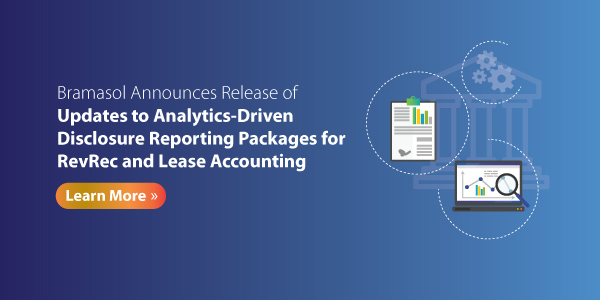Over recent years, several changes in the compliance landscape, such as ASC 606 / IFRS 15 on Revenue Recognition and ASC 842 / IFRS 16 on Lease Accounting, have radically altered the requirements for what data must be disclosed and how disclosure reporting is handled.
At the same time, major shifts in business models, such as the rise of the subscription economy and the move from product-focused sales to experience-focused solutions are fundamentally changing the ways that revenue is generated.
In addition, most companies are looking for ways to speed up their closing cycles in order to provide investors and other stakeholders with accurate and timely information in a shorter period of time.
The confluence of all these changes presents new opportunities for integrating advanced analytics into the disclosure reporting process to gather required information from a widening scope of line of business applications, while also improving the ability to visualize, analyze, drill-down and drill-through the data to understand and present it in required formats.
For example, in ASC 606 revenue disclosure reporting, companies need visualizations for various metrics over selected periods to help understand their past and future performance through insights such as:
- Do we have the right revenue mix between products and services?
- Are our revenues influenced by seasonality?
- What are our remaining performance obligations (POBs) by products and/or service
- Visualize contract balances (unbilled revenues and deferred revenues) by POB
Similarly, for ASC 842 lease accounting disclosure reports, companies need integrated analytics that can provide the following:
- Lease portfolio views by geography, asset class, incremental borrowing rate ranges and lease terms
- Lease expense and future lease commitments by category of assets, and geographic locations,
- Five-year lease commitment tables
- Simulations and what if scenarios for lease renewals, etc.
- Incremental borrowing rate (IBR) by asset class and geographic location
In order to deliver the full range of information in real-time and with agile manipulation of data for analysis, finance users need analytics dashboards optimized for visualization, along with flexible reports and the ability to drill-through into front-line applications such as SAP Revenue Accounting and Reporting (RAR), SAP Contract Lease Management (CLM) and to drill back to General Ledger detail.
In addition, the analytics and disclosure reporting tools must be able to seamlessly scale up for handling increasing large data sets, with real-time modeling and what-if scenarios.
Throughout the recent changes in Revenue Recognition and Lease Accounting compliance requirements, Bramasol has been at the forefront of implementing targeted SAP solutions and developing comprehensive disclosure reporting methodologies that are integrated with advanced analytics capabilities.
We are proud to have just released the latest updates to our analytics-driven disclosure reporting packages that incorporate a range of significant improvements to functionality, performance and scalability. In many instances, the changes are in response to customer requests and/or resulting from our hands-on work with customers to meet their real-world requirements while responding quickly to changing rules, guidance or interpretations of compliance regulations.
Learn more about Bramasol’s RevRec and Lease Accounting Disclosure Reporting Packages.


